Simple and Accurate Mathematical Modelling to Replace Ball’s Tables in Food Thermal Process Calculations
Abstract
1. Introduction
2. Materials and Methods
2.1. Brief Review of Ball’s Formula Method
2.1.1. Kinetics of Microbial Destruction at Constant Temperature
2.1.2. Reduction Exponent and Thermal Death Time
2.1.3. Influence of Temperature on the Kinetics of Microbial Destruction
2.1.4. Thermal Death at Variable Temperature
2.1.5. Exponential Decay–Heating Curve
2.1.6. Cooling Curve
2.1.7. Tables and Formula of Ball
2.2. Development of an Analytical Approximation of the Exponential Integral Function Ei
2.3. The Formula Method in Combination with the Analytical Approximation of the Ei Function
2.3.1. Heating Curve
2.3.2. Initial Cooling Curve
2.3.3. Exponential Decay–Cooling Curve
2.4. The Proposed Mathematical Modelling and Stoforos’ Modelling for a Comparison
2.4.1. Recap of the Proposed Mathematical Modelling
2.4.2. Stoforos’ Modelling and the Comparison Between the Two Models
3. Results and Discussion
4. Conclusions
Funding
Data Availability Statement
Conflicts of Interest
References
- Featherstone, S. A review of developments in and challenges in thermal processing over the past 200 years—A tribute to Nicolas Appert. Food Res. Int. 2012, 47, 156–160. [Google Scholar] [CrossRef]
- Mafart, P. Food engineering and predictive microbiology: On the necessity to combine biological and physical kinetics. Int. J. Food Microbiol. 2005, 100, 239–251. [Google Scholar] [CrossRef] [PubMed]
- Bigelow, W.D.; Bohart, G.S.; Richardson, A.C.; Ball, C.O. Heat Penetration in Processing Canned Foods, Bulletin 16-L Res., 1st ed.; Laboratory National Canners Associated: Washington, DC, USA, 1920; pp. 1–128. [Google Scholar]
- Ball, C.O. Mathematical Solution of Problems on Thermal Processing of Canned Food, Berkley: Publication Health, 1st ed.; University of California Publications in Public Health: Berkeley, CA, USA, 1928; pp. 15–245. [Google Scholar]
- Schultz, O.T.; Olson, F.C. Thermal processing of canned foods in tin containers. III. Recent improvements in the General Method of thermal process calculation. A special coordinate paper and methods of converting initial retort temperature. J. Food Sci. 1940, 5, 399–407. [Google Scholar] [CrossRef]
- Patashnik, M. A simplified procedure for thermal process evaluation. Food Technol. 1953, 7, 1–6. [Google Scholar]
- Hayakawa, K.I. A procedure for calculating the sterilizing value of a thermal process. Food Technol. 1968, 22, 93–95. [Google Scholar]
- Simpson, R.; Almonacid, S.; Teixeira, A.A. Bigelow’s General Method revisited: Development of a new calculation technique. J. Food Sci. 2003, 68, 1324–1333. [Google Scholar] [CrossRef]
- Ball, C.O. Thermal Process Times for Canned Foods, Bulletin 37, 1st ed.; National research Council: Washington, DC, USA, 1923; pp. 1–76. [Google Scholar]
- Ball, C.O.; Olson, F.C. Sterilization in Food Technology, 1st ed.; McGraw-Hill: New York, NY, USA, 1957; pp. 1–507. [Google Scholar]
- Stumbo, C.R. Thermobacteriology in Food Processing, 2nd ed.; Academic Press: New York, NY, USA, 1973; pp. 1–329. [Google Scholar]
- Hemdon, D.H.; Griffin, R.C., Jr.; Ball, C.O. Use of computer derived tables to calculate sterilizing processes for packaged foods. Food Technol. 1968, 22, 473–484. [Google Scholar]
- Griffin, R.C., Jr.; Hemdon, D.H.; Ball, C.O. Use of computer derived tables to calculate sterilizing processes for packaged foods. 2. Application to broken line heating curves. Food Technol. 1969, 23, 519–524. [Google Scholar]
- Griffin, R.C., Jr.; Hemdon, D.H.; Ball, C.O. Use of computer derived tables to calculate sterilizing processes for packaged foods 3. Application to cooling curves. Food Technol. 1971, 25, 134–143. [Google Scholar]
- Hayakawa, K. Experimental formulas for accurate estimation of transient temperature of food and their application to thermal process evaluation. Food Technol. 1970, 24, 1407–1418. [Google Scholar]
- Larkin, J.W. Use of a modified Ball’s formula method to evaluate aseptic processing of foods containing particulates. Food Technol. 1989, 43, 124–131. [Google Scholar]
- Steele, R.J.; Board, P.W. Thermal process calculations using sterilizing ratios. J. Food Technol. 1979, 14, 227–235. [Google Scholar] [CrossRef]
- Larkin, J.W.; Berry, R.B. Estimating cooling process lethality for different cooling j values. J. Food Sci. 1991, 56, 1063–1067. [Google Scholar] [CrossRef]
- Smith, T.; Tung, M.A. Comparison of formula methods for calculating thermal process lethality. J. Food Sci. 1982, 47, 626–630. [Google Scholar] [CrossRef]
- Kim, K.H.; Teixeira, A.A.; Bichier, J.; Tavares, J. STERILIMATE: Software for designing and evaluating thermal sterilization processes. In Proceedings of the American Society of Agricultural Engineers. Meeting (USA), Chicago, IL, USA, 15 December 1993. ASAE paper No 93–4051. [Google Scholar]
- Noronha, J.; Hendrickx, M.; Van Loey, A.; Tobback, P. New semi-empirical approach to handle time-variable boundary conditions during sterilization of non-conductive heating foods. J. Food Eng. 1995, 24, 249–268. [Google Scholar] [CrossRef]
- Teixeira, A.A.; Balaban, M.O.; Germer, S.P.M.; Sadahira, M.S.; Teixeira-Neto Vitali, R.O. Heat Transfer Model Performance in Simulation of Process Deviations. J. Food Sci. 1999, 64, 488–493. [Google Scholar] [CrossRef]
- Holdsworth, D.; Simpson, R. Thermal Processing of Packaged Foods, 2nd ed.; Springer: Berlin/Heidelberg, Germany, 2016; pp. 1–516. [Google Scholar]
- Miranda Zamora, W.R.; Sanchez Chero, M.J.; Sanchez Chero, J.A. Software for the Determination of the Time and the F Value in the Thermal Processing of Packaged Foods Using the Modified Ball Method. In Intelligent Human Systems Integration (IHSI 2020): Integrating People and Intelligent Systems; Ahram, T., Karwowski, W., Vergnano, A., Leali, F., Taiar, R., Eds.; Springer: Modena, Italy, 2020; Volume 1131, pp. 498–502. [Google Scholar] [CrossRef]
- Cleland, A.C.; Robertson, G.L. Determination of thermal processes to ensure commercial sterility of foods in cans. In Developments in Food Preservation, 1st ed.; Thorne, S., Ed.; Elsevier Applied Science: London, UK, 1985; Volume 3, pp. 1–315. [Google Scholar]
- Hayakawa, K.I. A critical review of mathematical procedures for determining proper heat sterilization processes. Food Technol. 1978, 32, 59–65. [Google Scholar]
- Stoforos, N.G.; Noronha, J.; Hendrickx, M.; Tobback, P.A. Critical analysis of mathematical procedures for the evaluation and design of in-container thermal processes for foods. Crit. Rev. Food Sci. Nutr. 1997, 37, 411–441. [Google Scholar] [CrossRef]
- Sojecka, A.A.; Drozd-Rzoska, A.; Rzoska, S.J. Food Preservation in the Industrial Revolution Epoch: Innovative High Pressure Processing (HPP, HPT) for the 21st-Century Sustainable Society. Foods 2024, 13, 3028. [Google Scholar] [CrossRef]
- Ghani, A.G.A.; Farid, M.M. Using the computational fluid dynamics to analyze the thermal sterilization of solid-liquid food mixture in cans. Innov. Food Sci. Emerg. 2006, 7, 55–61. [Google Scholar] [CrossRef]
- Augusto, P.E.D.; Cristianini, M. Numerical simulation of packed liquid food thermal process using computational fluid dynamics (CFD). Int. J. Food Eng. 2011, 7, 16. [Google Scholar] [CrossRef]
- Erdogdu, F. Optimization in Food Engineering, 1st ed.; CRC Press: Boca Raton, FL, USA, 2008; pp. 585–594. [Google Scholar] [CrossRef]
- Dimou, A.; Panagou, E.; Stoforos, N.G.; Yanniotis, S. Analysis of Thermal Processing of Table Olives Using Computational Fluid Dynamics. J. Food Sci. 2013, 78, 1695–1703. [Google Scholar] [CrossRef]
- Park, H.W.; Yoon, W.B. Computational Fluid Dynamics (CFD) Modelling and Application for Sterilization of Foods: A Review. Processes 2018, 6, 62. [Google Scholar] [CrossRef]
- Azar, A.B.; Ramezan, Y.; Khashehchi, M. Numerical simulation of conductive heat transfer in canned celery stew and retort program adjustment by computational fluid dynamics (CFD). Int. J. Food Eng. 2020, 16, 20190303. [Google Scholar] [CrossRef]
- Soleymani Serami, M.; Ramezan, Y.; Khashehchi, M. CFD simulation and experimental validation of in-container thermal processing in Fesenjan stew. Food Sci. Nutr. 2021, 9, 1079–1087. [Google Scholar] [CrossRef]
- Zhu, S.; Li, B.; Chen, G. Improving prediction of temperature profiles of packaged food during retort processing. J. Food Eng. 2022, 313, 110758. [Google Scholar] [CrossRef]
- Fu, Z.; Liu, H.; Huang, L.; Duan, L.; Wang, Y.; Sun, X.; Zhou, C. Numerical simulation of thermal sterilization heating process of canned fruits with different shapes based on UDM and RDM. Int. J. Food Eng. 2023, 19, 159–175. [Google Scholar] [CrossRef]
- Das, S.; Baro, R.K.; Kotecha, P.; Anandalakshmi, R. Numerical studies on thermal processing of solid, liquid, and solid–liquid food products: A comprehensive analysis. J. Food Process Eng. 2023, 46, e14484. [Google Scholar] [CrossRef]
- Dalvi-Isfahan, M. Effect of flow behavior index of CMC solutions on heat transfer and fluid flow in a cylindrical can. J. Food Process Eng. 2024, 47, e14672. [Google Scholar] [CrossRef]
- Sampanis, P.-A.; Chatzidakis, S.M.; Stoforos, G.N.; Stoforos, N.G. Analysis of Shell Egg Pasteurization Using Computational Fluid Dynamics. Appl. Sci. 2025, 15, 1263. [Google Scholar] [CrossRef]
- Szpicer, A.; Bińkowska, W.; Stelmasiak, A.; Zalewska, M.; Wojtasik-Kalinowska, I.; Piwowarski, K.; Piepiórka-Stepuk, J.; Półtorak, A. Computational Fluid Dynamics Simulation of Thermal Processes in Food Technology and Their Applications in the Food Industry. Appl. Sci. 2025, 15, 424. [Google Scholar] [CrossRef]
- Calomino, G.E.; Minim, L.A.; Coimbra, J.S.D.; Rodrigues Minim, V.P. Thermal process calculation using artificial neural networks and other traditional methods. J. Food Process Eng. 2006, 29, 162–173. [Google Scholar] [CrossRef]
- Gautschi, W.; Cahill, W.F. Exponential integral and related functions. In Handbook of Mathematical Functions, 1st ed.; Abramowitz, M., Stegun, I.A., Eds.; National Bureau of Standards: Washington, DC, USA, 1964; Appl Math Ser; Volume 55, pp. 227–237. [Google Scholar]
- Stoforos, N.G. Thermal process calculations through Ball’s original formula method: A critical presentation of the method and simplification of its use through regression equations. Food Eng. Rev. 2010, 2, 1–16. [Google Scholar] [CrossRef]
- Friso, D. A new mathematical model for food thermal process prediction. Model. Simul. Eng. 2013, 2013, 1–8. [Google Scholar] [CrossRef]
- Friso, D. A Mathematical Solution for Food Thermal Process Design. Appl. Math. Sci. 2015, 9, 255–270. [Google Scholar] [CrossRef]
- Friso, D. The Check Problem of Food Thermal Processes: A Mathematical Solution. Appl. Math. Sci. 2015, 9, 6529–6546. [Google Scholar] [CrossRef]
- Wolframalpha. Available online: https://www.wolframalpha.com (accessed on 20 April 2025).
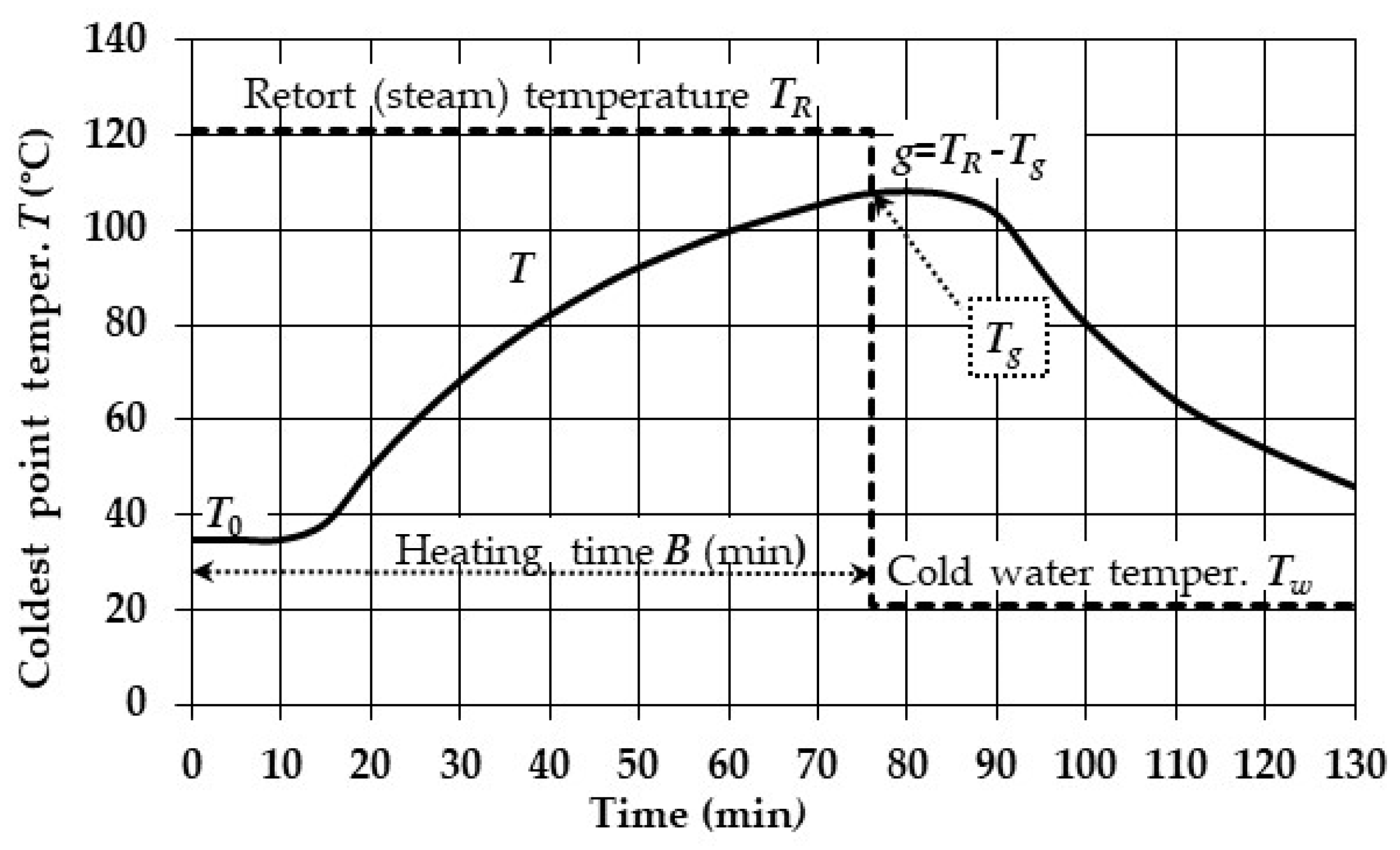


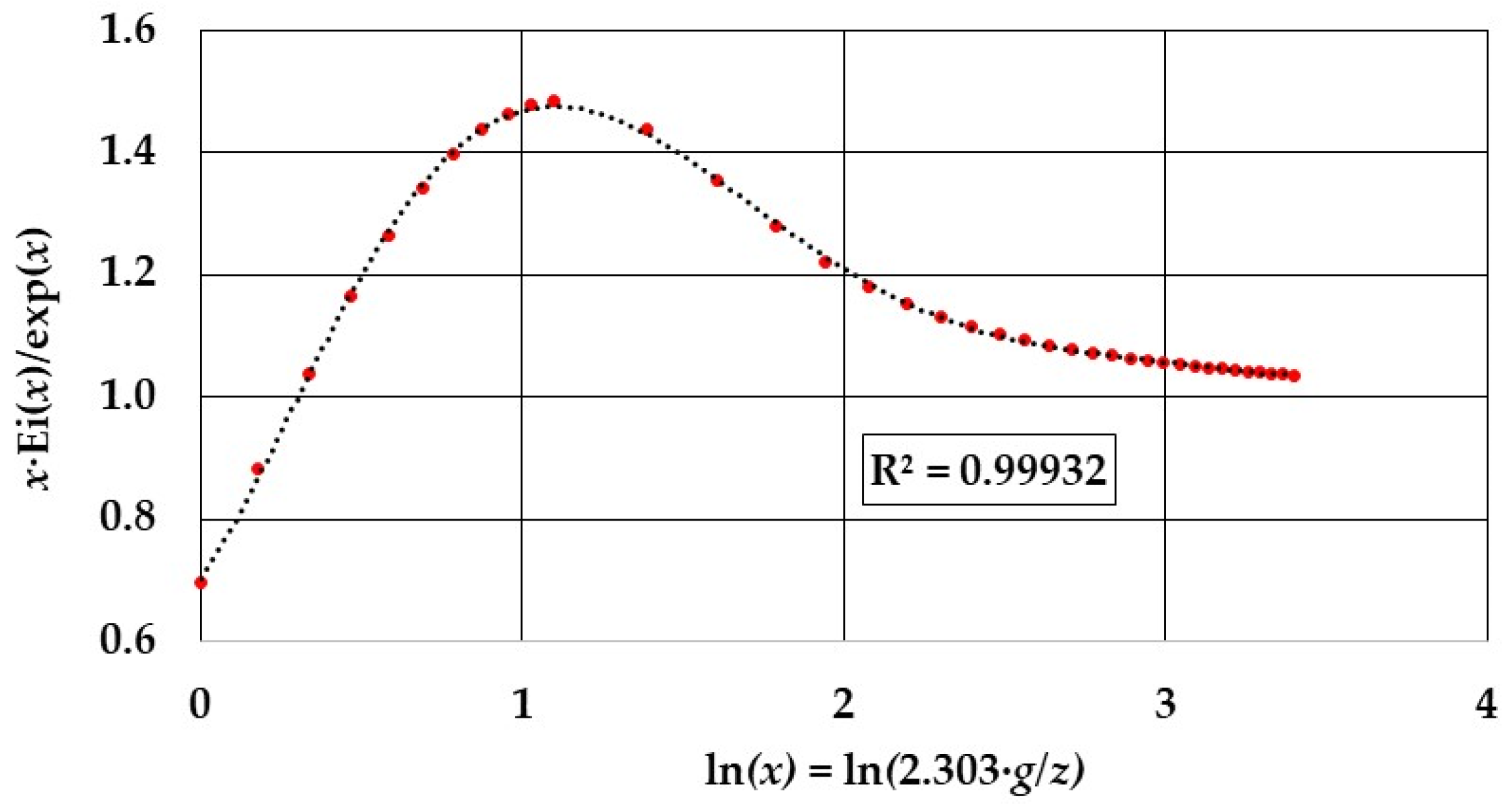
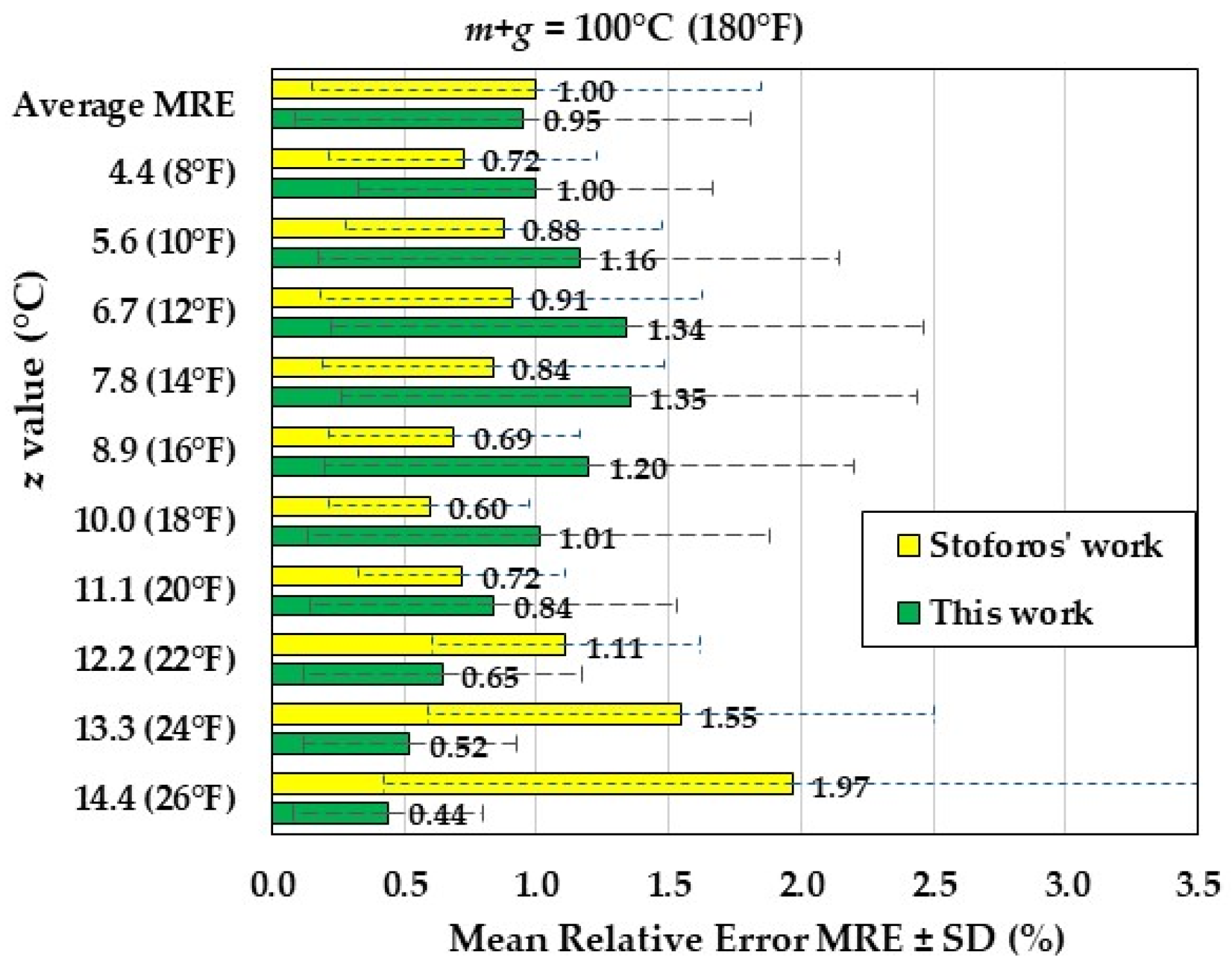


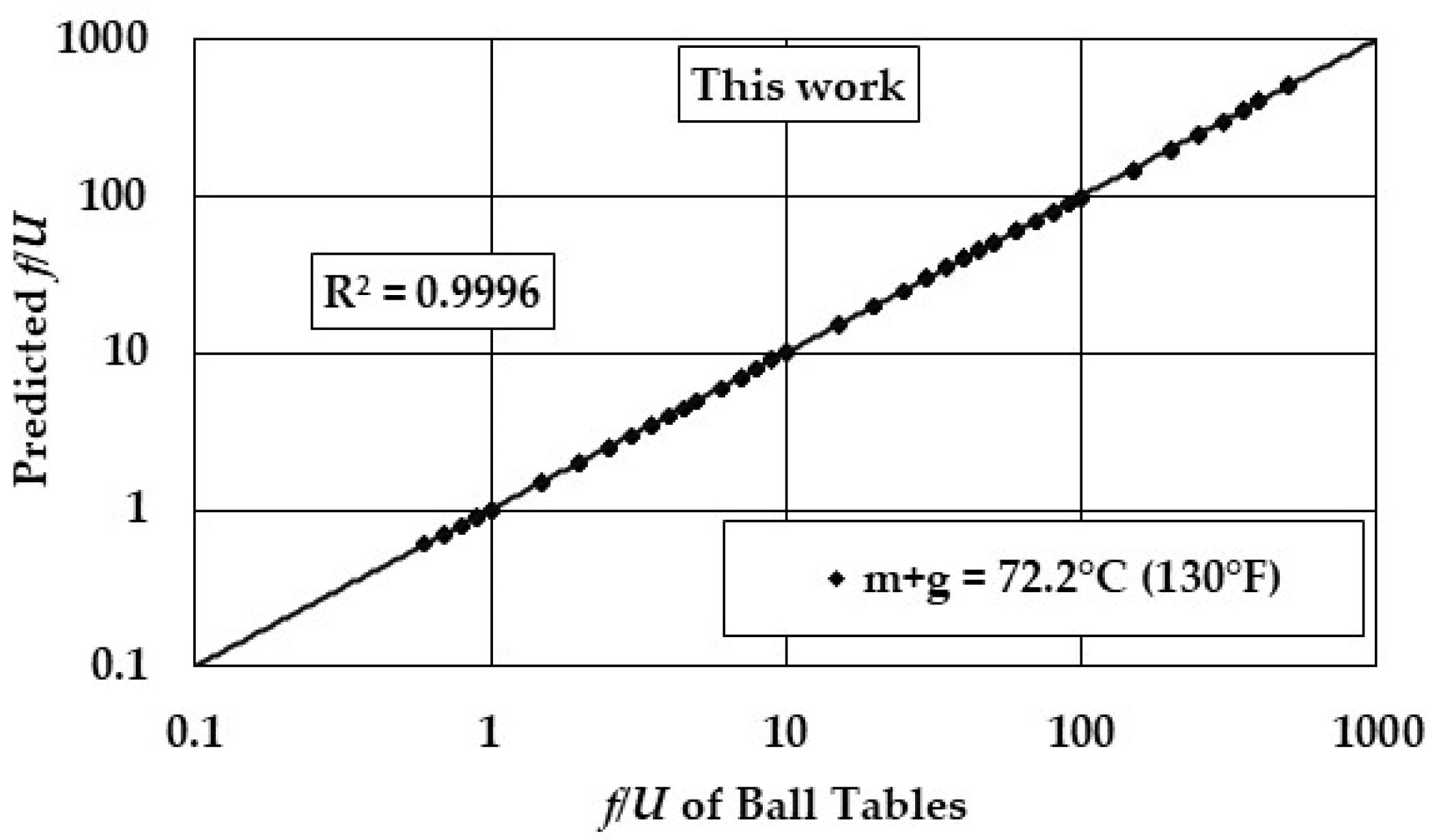
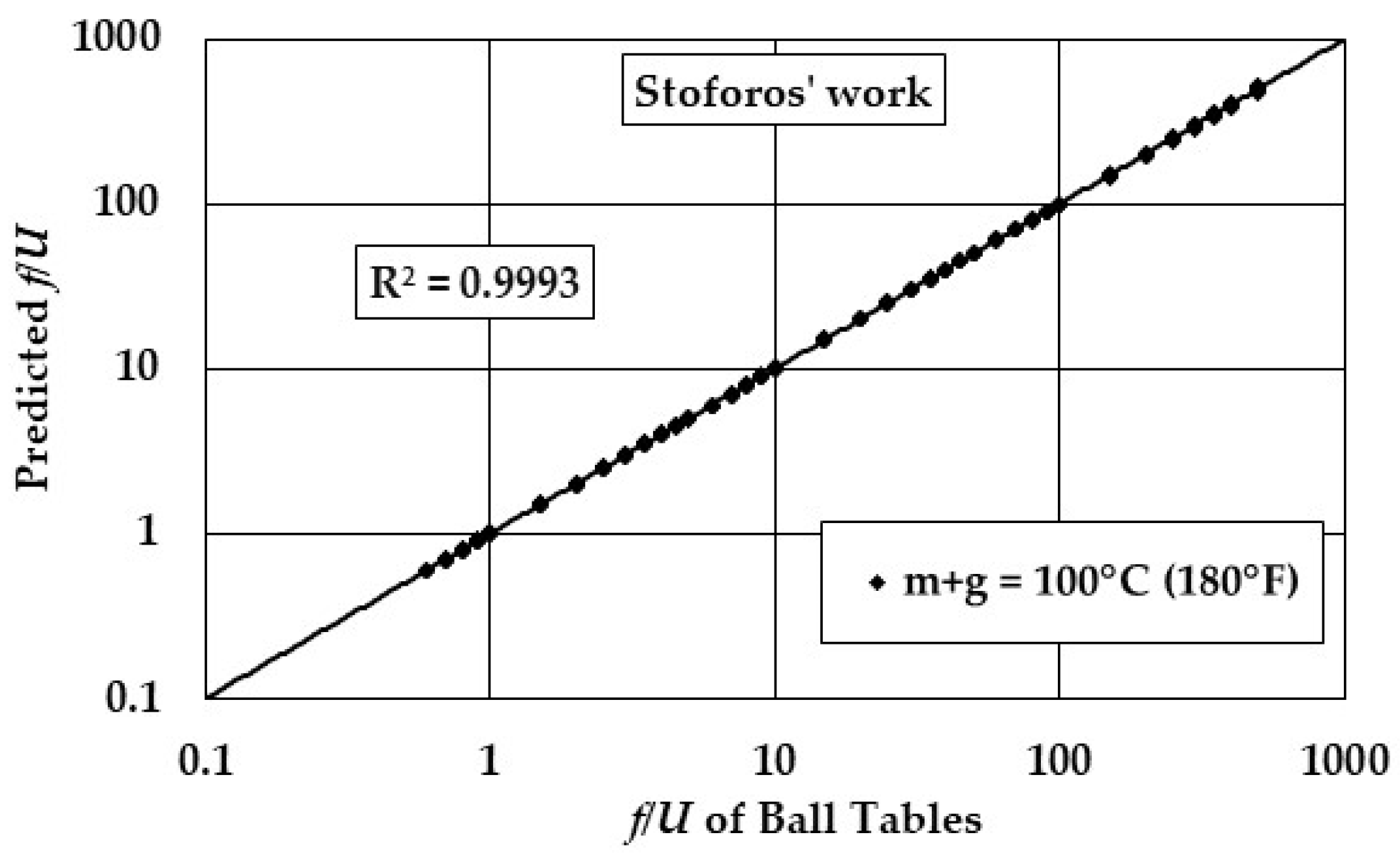
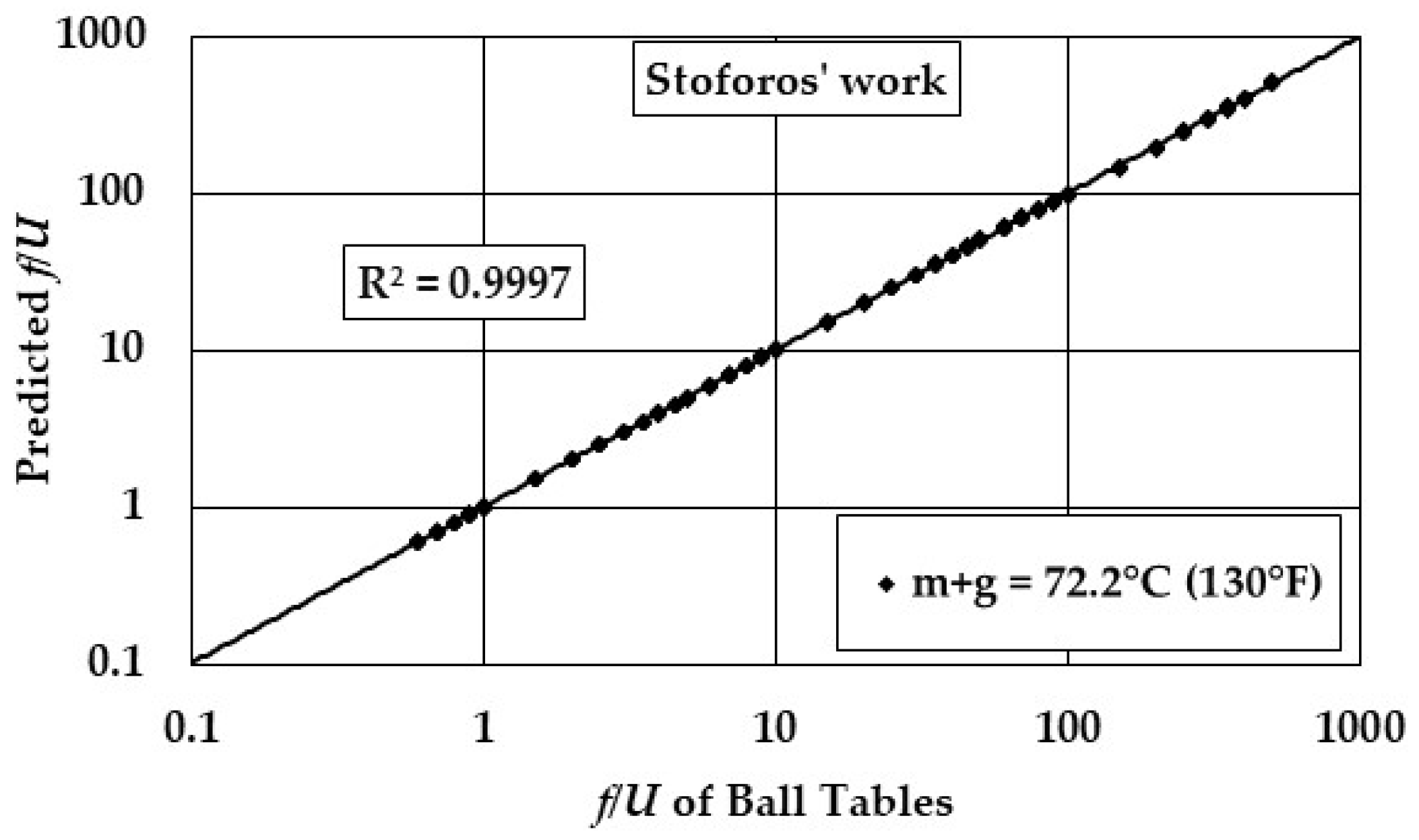
| x | Ei(−x) |
|---|---|
| 0.11 | −1.6974 |
| 1.15 | −0.1716 |
| 3.22 | −0.009882 |
| 6.21 | −0.0002831 |
| 9.20 | −0.000009988 |
| 12.19 | −0.0000003872 |
| 15.18 | −0.00000001584 |
| 18.17 | −0.0000000006719 |
| 21.16 | −0.00000000002921 |
| 24.15 | −0.000000000001294 |
| 27.14 | −0.00000000000005814 |
| 30.13 | −0.000000000000002642 |
Disclaimer/Publisher’s Note: The statements, opinions and data contained in all publications are solely those of the individual author(s) and contributor(s) and not of MDPI and/or the editor(s). MDPI and/or the editor(s) disclaim responsibility for any injury to people or property resulting from any ideas, methods, instructions or products referred to in the content. |
© 2025 by the author. Licensee MDPI, Basel, Switzerland. This article is an open access article distributed under the terms and conditions of the Creative Commons Attribution (CC BY) license (https://creativecommons.org/licenses/by/4.0/).
Share and Cite
Friso, D. Simple and Accurate Mathematical Modelling to Replace Ball’s Tables in Food Thermal Process Calculations. Processes 2025, 13, 1975. https://doi.org/10.3390/pr13071975
Friso D. Simple and Accurate Mathematical Modelling to Replace Ball’s Tables in Food Thermal Process Calculations. Processes. 2025; 13(7):1975. https://doi.org/10.3390/pr13071975
Chicago/Turabian StyleFriso, Dario. 2025. "Simple and Accurate Mathematical Modelling to Replace Ball’s Tables in Food Thermal Process Calculations" Processes 13, no. 7: 1975. https://doi.org/10.3390/pr13071975
APA StyleFriso, D. (2025). Simple and Accurate Mathematical Modelling to Replace Ball’s Tables in Food Thermal Process Calculations. Processes, 13(7), 1975. https://doi.org/10.3390/pr13071975






